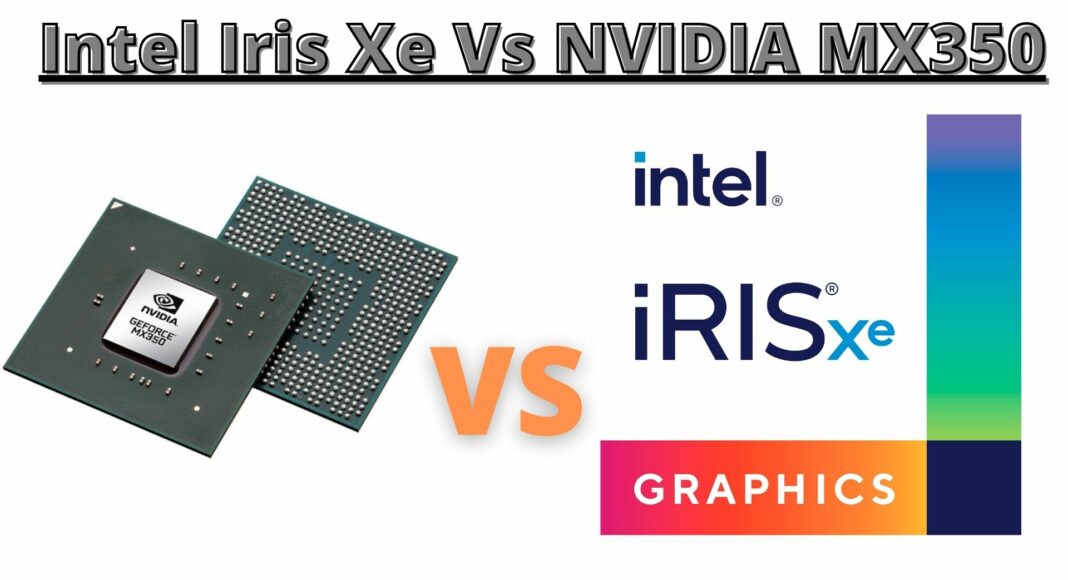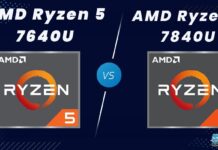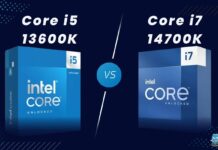Intel Iris Xe
Rated: 6/10
Nvidia GeForce MX350
Rated: 6.5/10
Pros And Cons
| Graphics | Pros | Cons |
|---|---|---|
| Nvidia GeForce MX350 | ✅Better overall performance ✅Slightly lower TDP | ❌Higher price tag |
| Intel Iris Xe | ✅Lower price tag ✅Better performance in some games | ❌Higher TDP |
- In our tests, the Intel Iris Xe graphics ran around 7% slower than the Nvidia GeForce MX350, but they traded punches frequently from game to game.
- The MX350 has a lower TDP than its rival, though the difference is fairly small.
- As a general rule of thumb, the Nvidia card is more expensive than the Intel offering in laptops, though this varies depending on the machine you wish to buy.
Comparison Table
| Features | Intel Iris Xe Max | Nvidia GeForce MX350 |
|---|---|---|
| Bus Interface | PCIe 4.0 x8 | PCIe 3.0 x4 |
| Shading Units | 768 | 640 |
| TMUs | 48 | 32 |
| ROPs | 24 | 16 |
| GPU Name | DG1 | GP107 |
| Architecture | Generation 12.1 | Pascal |
| Foundry | Intel | Samsung |
| Type | Mobile | Mobile |
| Release Date | Oct 2020 | Feb 2020 |
Architectural Differences
- Frequency: The Iris Xe Max variant’s base clock is 300MHz, significantly lower than the MX350’s 747MHz clock. The Iris graphics boost is up to 1650MHz, much higher than the MX350’s 937MHz boost.
- VRAM: The Iris graphics can share up to 4GB of LPDDR4x memory with the rest of your system, while the MX350 uses a slower, yet faster 2GB GDDR5 memory buffer.
- Bus Width: The Intel graphics have a bus width of 128 bits, whereas the MX350 has a 64-bit bus.
- Manufacturing Nodes: Nvidia’s MX350 is based on a 14nm Pascal architecture, whereas the Iris graphics use 10nm processing nodes.
- TDP: Because of its lackluster specs, the MX350 has a TDP of only 20 watts, slightly lower than the Iris’ 25 watts.
- API Support: Iris XE lacks CUDA support but fully supports DirectX, Shader Model, OpenGL, OpenCL, and Vulkan. Similarly, the Nvidia Mx350, which has strong support, utilizes the Vulkan Graphics API.
Despite popular belief, not every graphics card Nvidia has released has been a powerhouse, and some are even slow enough to match Intel’s integrated graphics. Does the MX350 fall into this trope? Keep reading our Intel Iris Xe vs Nvidia MX350 comparison to find out!
Gaming Benchmarks – 1080 Low
With the specifications out of the way, the following parts of the comparison will illustrate the performance of these cards in games. Both the cards are low-powered, so we tested their performance on the lowest presets at 1080p.
Test Benches
Lenovo IdeaPad 5 15ILL05:
- GPU – NVIDIA GeForce MX350 / 2GB (GDDR5)
- CPU – Intel i7 1065G7
- RAM – 16GB DDR4
- Storage – 1TB NVMe SSD
DELL INSPIRON 7506 2in1:
- CPU – Intel i7 1165G7 (Iris XE)
- GPU – Intel Iris XE MAX 4GB DDR4 3200 Mhz (20-25W)
- RAM – 16GB DDR4
- Storage – 1TB NVMe SSD
We tried to find laptops with specs that were as similar as possible to the different GPUs. Still, there can be some variance from laptop to laptop because of ventilation and heat dissipation.
Shadow of the Tomb Raider

- On average, we saw a 6% improvement with the Nvidia card in SOtTR, with the card getting a framerate of around 35 FPS instead of 33 FPS of the Iris card.
Wither 3

- The MX350 took a loss in The Witcher 3 with a framerate of 31 FPS, around 22% lower than the Iris’ average of 38 FPS.
Rocket League

- The Nvidia card stretched its legs in Rocket League, getting an average framerate of 93 FPS against the Xe’s 74 FPS, showing a 25% improvement in performance.
Forza Horizon 4

- The standards flipped once again in Forza, with the MX350 getting an average framerate of 26 FPS, whereas the Intel card hovered closer to 31 FPS, leading to a 19% difference between the two.
GTA V

- Testing out this cornerstone Rockstar game showed the MX350 with an average framerate of 35 FPS, while the Iris Xe held closer to 29 FPS, with a lot of spikes and dips. This led to a performance difference of over 20%.
Overall Gaming Performance

In our test of the Intel Iris Xe vs Nvidia MX350, we found that the Nvidia card edged out its competition slightly in terms of overall numbers.
It had an average framerate of 44 FPS in our testing, around 7% better than the Iris Xe’s average of 41 FPS.
It is important to note that though the average framerate was greater on the Nvidia card, Intel took serious victories over its competitor in some games. Furthermore, our testing showed the Intel card to be more unstable, whereas the MX350 stuck closer to its average framerate.
Price & Availability
Though it is hard to pinpoint a price with either GPU, the Intel Iris Xe Max generally comes in a slightly cheaper package. Still, this factor depends entirely on the laptop you wish to buy, so do your due diligence before cashing it in.
Intel Iris Xe Vs Nvidia MX350 – Verdict
Nvidia Geforce MX350: Being a low-powered equivalent to integrated graphics, this video card fails to amaze us. Its low performance is only good for light gaming on the go. It does bring a fair advantage in its very low power consumption, but more power-efficient options exist.
Intel Iris Xe: Depending on the variant of this card you get, you can have many experiences. The one we tested had sub-par but adequate performance. It also has low power consumption, albeit higher than the MX350.
There is no clear “good choice” between these two graphics options, making our recommendation much harder. If you are deciding between the Intel Iris Xe vs Nvidia MX350 graphics, try to look at the specific laptops you are buying and evaluate them from there.
Frequently Asked Questions
The Iris Xe Max graphics were released around 8 months after the MX350.
The Iris Xe come in various configurations like the 96EU, the 80EU, the G7s and the G4.
The Iris Xe has 68 GB/s of bandwidth, while the MX350 has a bandwidth of 56 GB/s.
Similar Comparisons:
Thank you! Please share your positive feedback. 🔋
How could we improve this post? Please Help us. 😔
[Comparisons Specialist]
I’m a passionate computer hardware expert specializing in CPUs and GPUs. With a lifelong curiosity for hardware and extensive hands-on experience, I provide valuable insights, practical advice, and in-depth analysis on these components. Engaging with the hardware community, I exchange knowledge and stay at the forefront of technological advancements.
Get In Touch: uzair@tech4gamers.com









Feedback By: